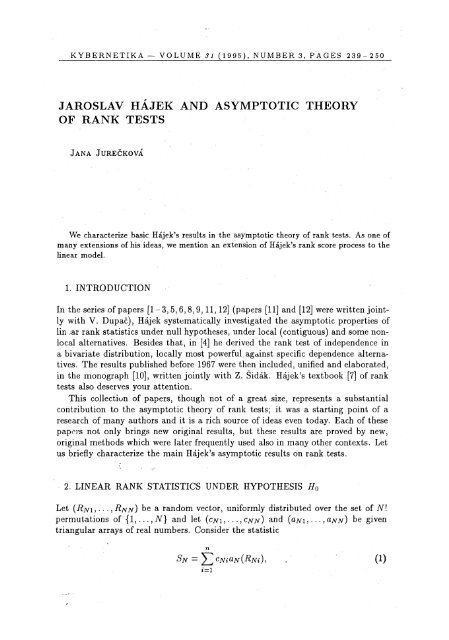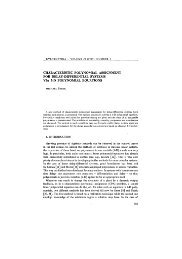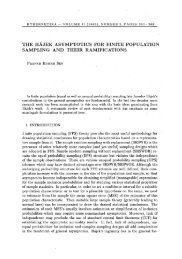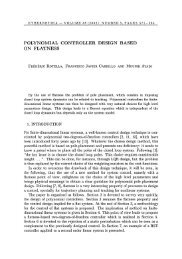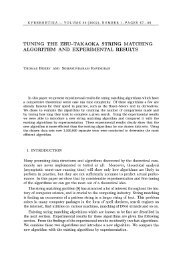jaroslav hajek and asymptotic theory of rank tests - Kybernetika
jaroslav hajek and asymptotic theory of rank tests - Kybernetika
jaroslav hajek and asymptotic theory of rank tests - Kybernetika
You also want an ePaper? Increase the reach of your titles
YUMPU automatically turns print PDFs into web optimized ePapers that Google loves.
KYBERNETIKA — VOLUME 31 (1995), NUMBER 3, PAGES 239-250<br />
JAROSLAV HAJEK AND ASYMPTOTIC THEORY<br />
OF RANK TESTS<br />
JANA<br />
JUREČKOVÁ<br />
We characterize basic Hajek's results in the <strong>asymptotic</strong> <strong>theory</strong> <strong>of</strong> <strong>rank</strong> <strong>tests</strong>. As one <strong>of</strong><br />
many extensions <strong>of</strong> his ideas, we mention an extension <strong>of</strong> Hajek's <strong>rank</strong> score process to the<br />
linear model.<br />
1. INTRODUCTION<br />
In the series <strong>of</strong> papers [1-3,5,6,8,9,11,12] (papers [11] <strong>and</strong> [12] were written jointly<br />
with V. Dupac), Hajek systematically investigated the <strong>asymptotic</strong> properties <strong>of</strong><br />
linear <strong>rank</strong> statistics under null hypotheses, under local (contiguous) <strong>and</strong> some nonlocal<br />
alternatives. Besides that, in [4] he derived the <strong>rank</strong> test <strong>of</strong> independence in<br />
a bivariate distribution, locally most powerful against specific dependence alternatives.<br />
The results published before 1967 were then included, unified <strong>and</strong> elaborated,<br />
in the monograph [10], written jointly with Z. Sidak. Hajek's textbook [7] <strong>of</strong> <strong>rank</strong><br />
<strong>tests</strong> also deserves your attention.<br />
This collection <strong>of</strong> papers, though not <strong>of</strong> a great size, represents a substantial<br />
contribution to the <strong>asymptotic</strong> <strong>theory</strong> <strong>of</strong> <strong>rank</strong> <strong>tests</strong>; it was a starting point <strong>of</strong> a<br />
research <strong>of</strong> many authors <strong>and</strong> it is a rich source <strong>of</strong> ideas even today. Each <strong>of</strong> these<br />
papers not only brings new original results, but these results are proved by new,<br />
original methods which were later frequently used also in many other contexts. Let<br />
us briefly characterize the main Hajek's <strong>asymptotic</strong> results on <strong>rank</strong> <strong>tests</strong>.<br />
2. LINEAR RANK STATISTICS UNDER HYPOTHESIS H 0<br />
Let (RNI, • • •, RNN) be a r<strong>and</strong>om vector, uniformly distributed over the set <strong>of</strong> N!<br />
permutations <strong>of</strong> {1,...,N} <strong>and</strong> let (CNI, • • •, CNN) <strong>and</strong> (ajvi • • • • >
240 J. JURECKOVA<br />
where a N<br />
(i)<br />
= a N<br />
{, i = 1,..., N, <strong>and</strong><br />
a N<br />
(l)
Jaroslav Hajek <strong>and</strong> Asymptotic Theory <strong>of</strong> Rank Tests 241<br />
Theorem 2.2. (Asymptotic representation) Under (l)-(3) <strong>and</strong> (5),<br />
where<br />
[Nu] denotes the integer part <strong>of</strong> Nu <strong>and</strong><br />
S N = T N + r N , (9)<br />
At<br />
T N = Y^c Ni a N ([NUi] + l), (10)<br />
i_l<br />
Er N /var T N -> 0 as N -> oo. (11)<br />
Among various possible choices <strong>of</strong> the a Ni , Hajek also considered<br />
a Ni = E((p(U!)\R N i = i) = E
242 j. JUREČKOVÁ<br />
where
Jaroslav Hájek <strong>and</strong> Asymptotic Theory <strong>of</strong> Rank Tests 243<br />
Theorem 4.1. (Variance inequality) Let Xi,... ,XN be independent r<strong>and</strong>om<br />
variables with the <strong>rank</strong>s Hi,..., RN <strong>and</strong> arbitrary continuous distribution functions<br />
El,..., FN- Let (ci,..., CN) <strong>and</strong> (ai,..., a;v) be arbitrary vectors, a\ < ... < ajy.<br />
Then<br />
vаr<br />
N<br />
У^ CІU(RІ)<br />
,i = l<br />
N<br />
< 21 mаx (CІ - č") У^(a,- - ã) 2 , (22)<br />
Ki
244 J. JURECKOVA<br />
Using the fact that, to any function ip being a difference <strong>of</strong> two nondecreasing,<br />
square-integrable functions, absolutely continuous inside (0,1), <strong>and</strong> to any a > 0,<br />
there exists a decomposition<br />
(t) +
Jaroslav Hájek <strong>and</strong> Asymptotic Theory <strong>of</strong> Rank Tests 245<br />
where / is an arbitrary one-dimensional density.<br />
Hajek attacked this problem using the weak convergence <strong>of</strong> empirical processes<br />
which was a pioneering method in 1965. He considered the <strong>rank</strong>-scores process<br />
XN = I X N (t) = ^c Ni a Ni (t), 0
246 J. JURECKOVA<br />
6. FURTHER ASYMPTOTIC PROPERTIES OF RANKS<br />
Hajek [9] demonstrated that not only the best Pitman efficiency but also the best<br />
exact Bahadur slope is attainable by <strong>rank</strong> statistics; otherwise speaking, that the<br />
vector <strong>of</strong> <strong>rank</strong>s is sufficient in the Bahadur sense.<br />
Consider the two-sample model with independent samples X\,..., X n <strong>and</strong> Y\,...<br />
. .. ,Y m with the respective densities <strong>and</strong> d.f.'s /, g, F, G; let limAr^oo w+n = \ £<br />
(0,1) <strong>and</strong> denote<br />
H(x) = \F(x) + (l-\)G(x), xeRi, (42)<br />
J(u)=-^-F(H- l (u)), g( u )=±G(H- 1 (u)), 0
Jaroslav Hájek <strong>and</strong> Asymptotic Theory <strong>of</strong> Rank Tests 247<br />
7. EXTENSION OF RANK-SCORES PROCESS TO REGRESSION MODEL<br />
Hajek's results <strong>and</strong> methods were used <strong>and</strong> extended by a host <strong>of</strong> statisticians;<br />
it is impossible to characterize all this work as a whole. Among many possible<br />
extensions, let us briefly describe a recent extension <strong>of</strong> Hajek's <strong>rank</strong>-scores process<br />
to linear regression model, which in turn has further interesting applications.<br />
Consider the linear regression model<br />
Yi = x'i(3 + Ei, i=l,...,n (50)<br />
with Xi € R p , xn = 1, t = 1,... ,p <strong>and</strong> with independent errors E\,... ,E n . Koenker<br />
<strong>and</strong> Bassett [25] introduced the a-regression quantile (3(a) (0 < a < 1) for model<br />
(50) as a solution <strong>of</strong> the minimization<br />
where<br />
n<br />
^p a (Yi - x'ib) •- min, 6
248 J. JUREČKOVA<br />
a^2 r t + ( l_a )lZ r i = m i n<br />
»=i<br />
i=i<br />
p<br />
Yl Xi i%- ¥r t- r 7 : =Yi> » = l,...,n ( 55 )<br />
i=i<br />
PjERi, j = 1,... ,p\ rf > 0, r,~ > 0, i = 1,..., n; 0 < a < 1.<br />
The dual program to (55) can be written as follows<br />
n<br />
j>YiCti := max<br />
i=l<br />
n<br />
J>.;(a,-(l-a)) = 0, j* = l,...p (56)<br />
t=i<br />
0 < a,- < 1, i= l,...,n; 0 < a < 1.<br />
By the duality <strong>of</strong> (55) <strong>and</strong> (56), the optimal solution <strong>of</strong> (56),<br />
satisfies the inequalities<br />
o-n(a) = (a n i(a),..., a nn (a))'<br />
àni(oc)) = {<br />
...Yi>x>(3(a)<br />
0 ...Yi
Jaroslav Hájek <strong>and</strong> Asymptotic Theory <strong>of</strong> Rank Tests 249<br />
<strong>rank</strong> scores process are studied in Gutenbrunner <strong>and</strong> Jureckova [20], Gutenbrunner,<br />
Jureckova, Koenker <strong>and</strong> Portnoy [21] <strong>and</strong> Jureckova [23]. [21] <strong>and</strong> [24] construct the<br />
linear <strong>and</strong> nonlinear <strong>tests</strong> <strong>of</strong> the hypothesis H : 6 = 0 in the extended linear model<br />
Y = X(3 + Z6 + E (60)<br />
with X <strong>of</strong> order (n x p), xn = 1, i = 1,..., n, Z <strong>of</strong> order (n x q) <strong>and</strong> where (3 is<br />
considered as a nuisance parameter. Tests based on regression <strong>rank</strong> scores calculated<br />
via (56) under the hypothesis H, i.e. under Y = X(3 + E, are invariant to the X-<br />
regression <strong>and</strong> therefore invariant to the nuisance j3. Their structure is analogous<br />
to that <strong>of</strong> ordinary <strong>rank</strong> <strong>tests</strong>, <strong>and</strong> so is their Pitman efficiency. More details could<br />
be found in the papers mentioned above where other papers, also concerning the<br />
pertaining computional algorithms, are cited. The research is still in the progress;<br />
our ultimate goal is to establish the <strong>asymptotic</strong>s <strong>of</strong> regression <strong>rank</strong>-scores <strong>tests</strong> under<br />
the weakest possible regularity conditions, keeping in mind that their counterpart<br />
<strong>tests</strong>, based solely on the ordinary <strong>rank</strong>s, are practically universal.<br />
ACKNOWLEDGEMENT<br />
The research was supported by the Grant Agency <strong>of</strong> the Czech Republic under Grant<br />
No. 2168. The paper was partially written while the author was visiting in Universite<br />
Bordeaux 2, Laboratoire de Mathematiques Stochastiques under the C.N.R.S. support<br />
(JF-91).<br />
REFERENCES<br />
(Received October 26, 1994.)<br />
[1] J. Hajek: Some extensions <strong>of</strong> the Wald-W<strong>of</strong>owitz-Noether theorem. Ann. Math. Statist.<br />
32 (1961), 506-523.<br />
[2] J. Hajek: Asymptotically most powerful <strong>rank</strong> order <strong>tests</strong>. Ann. Math. Statist. 33<br />
(1962), 1124-1147.<br />
[3] J. Hajek: Extension <strong>of</strong> the Kolmogorov-Smirnov test to the regression alternatives.<br />
Bernoulli-Bayes-Laplace. In: Proc. Internat. Research Seminar (J. Neyman <strong>and</strong> L.<br />
LeCam, eds.), Springer-Verlag, Berlin 1965, pp. 45-60.<br />
[4] J. Hajek: Locally most powerful <strong>tests</strong> <strong>of</strong> independence. In: Studies in Math. Statist.<br />
(K. Sarkadi <strong>and</strong> I. Vincze, eds.), Akademiai Kiado, Budapest 1968, pp. 45-51.<br />
[5] J. Hajek: Some new results in the <strong>theory</strong> <strong>of</strong> <strong>rank</strong> <strong>tests</strong>. In: Studies in Math. Statist.<br />
(K. Sarkadi <strong>and</strong> I. Vincze, eds.), Akademiai Kiado, Budapest 1968, pp. 53-55.<br />
[6] J. Hajek: Asymptotic normality <strong>of</strong> simple linear <strong>rank</strong> statistics under alternatives.<br />
Ann. Math. Statist. 39 (1968), 325-346.<br />
[7] J. Hajek: A Course in Nonparametric Statistics. Holden-Day, San Francisco 1969.<br />
[8] J. Hajek: Miscellaneous problems <strong>of</strong> <strong>rank</strong> test <strong>theory</strong>. In: Nonparam. Techniques in<br />
Statist. Inference (M.L. Puri, ed.), Cambridge Univ. Press 1970, pp. 3-19.<br />
[9] J. Hajek: Asymptotic sufficiency <strong>of</strong> the vector <strong>of</strong> <strong>rank</strong>s in the Bahadur sense. Ann.<br />
Statist. 2 (1974), 75-83.<br />
[10] J. Hajek <strong>and</strong> Z. Sidak: Theory <strong>of</strong> Rank Tests. Academia, Prague <strong>and</strong> Academic Press,<br />
New York 1967. (Russian translation: Nauka, Moscow 1971.)<br />
[11] J. Hajek <strong>and</strong> V. Dupac: Asymptotic normality <strong>of</strong> simple linear <strong>rank</strong> statistics under<br />
alternatives II. Ann. Math. Statist. ^0 (1969), 1992-2017.
250 J. JUREČKOVÁ<br />
[12] J. Hajek <strong>and</strong> V. Dupac: Asymptotic normality <strong>of</strong> the Wilcoxon statistic under divergent<br />
alternatives. Zastos. Mat. 10 (1969), 171-178.<br />
[13] H. Chern<strong>of</strong>f <strong>and</strong> I. R. Savage: Asymptotic normahty <strong>and</strong> efficiency <strong>of</strong> certain nonparametric<br />
test statistics. Ann. Math. Statist. 29 (1958), 972-994.<br />
[14] M. D. Donsker: Justification <strong>and</strong> extension <strong>of</strong> Doob's heuristic approach to the<br />
Kolmogorov-Smirnov theorems. Ann. Math. Statist. £5(1952), 277-281.<br />
[15] J.L. Doob: Heuristic approach to the Kolmogorov-Smirnov theorems. Ann. Math.<br />
Statist. 20 (1949), 393-403.<br />
[16] M. Driml: Convergence <strong>of</strong> compact measures on metric spaces. In: Trans. 2nd Prague<br />
Conference on Inform. Theory, NCSAV, Prague 1959, pp. 71-92.<br />
[17] M. Dwass: On the <strong>asymptotic</strong> normahty <strong>of</strong> certain <strong>rank</strong> order statistics. Ann. Math.<br />
Statist. 24 (1953), 303-306.<br />
[18] M. Dwass: On the <strong>asymptotic</strong> normahty <strong>of</strong> some statistics used in non-parametric<br />
setup. Ann. Math. Statist. 26 (1955), 334-339.<br />
[19] Z. Govindarajulu, L. LeCam <strong>and</strong> M. Raghavachari: Generalizations <strong>of</strong> theorems <strong>of</strong><br />
Chern<strong>of</strong>f <strong>and</strong> Savage on the <strong>asymptotic</strong> normality <strong>of</strong> test statistics. In: Proc. 5th<br />
Berkeley Symp. Math. Statist. Probab. 1 (1966), pp. 609-638.<br />
[20] C. Gutenbrunner <strong>and</strong> J. Jureckova: Regression <strong>rank</strong> scores <strong>and</strong> regression quantiles.<br />
Ann. Statist. 20 (1992), 305-330.<br />
[21] C. Gutenbrunner, J. Jureckova, R. Koenker <strong>and</strong> S. Portnoy: Tests <strong>of</strong> linear hypotheses<br />
based on regression <strong>rank</strong> scores. J. Nonpar. Statist. 2 (1993), 307-331.<br />
[22] W. Hoeffding: A combinatorial central hmit theorem. Ann. Math. Statist. 22 (1951)<br />
558-566.<br />
[23] J. Jureckova: Uniform <strong>asymptotic</strong> linearity <strong>of</strong> regression <strong>rank</strong> scores process. In: Nonpar.<br />
Statist. Rel. Topics (A. K. Md. E. Saleh, ed.), Elsevier Sci. Publ. 1992, pp. 217-228.<br />
[24] J. Jureckova: Tests <strong>of</strong> Kolmogorov-Smirnov type based on regression <strong>rank</strong> scores. In:<br />
Trans. 11th Prague Conference on Inform. Theory (J.A.Visek, ed.), Academia, Prague<br />
<strong>and</strong> Kluwer Acad. Publ. 1992, pp. 41-49.<br />
[25] R. Koenker <strong>and</strong> G. Bassett: Regression quantiles. Econometrica 46 (1978), 33-50.<br />
[26] M. Motoo: On the Hoeffding's combinatorial central hmit theorem. Ann. Inst. Statist.<br />
Math. 5(1957), 145-154.<br />
[27] G. E. Noether: On a theorem <strong>of</strong> Wald <strong>and</strong> Wolfowitz. Ann. Math. Statist. 20 (1949),<br />
455-458.<br />
[28] Ju. V. Prochorov: Convergence <strong>of</strong> stochastic processes <strong>and</strong> hmiting theorems <strong>of</strong> probability<br />
<strong>theory</strong>. Theory Probab. 1 (1956), 177-238.<br />
[29] R. Pyke <strong>and</strong> G. R. Shorack: Weak convergence <strong>of</strong> a two-sample empirical process <strong>and</strong><br />
anew approach to Chern<strong>of</strong>f-Savage theorems. Ann. Math. Statist. 59(1968), 755-771.<br />
[30] M. Raghavachari: On a theorem <strong>of</strong> Bahadur on the rate <strong>of</strong> convergence <strong>of</strong> <strong>tests</strong> statistics.<br />
Ann. Math. Statist. 41 (1970), 1695-1699.<br />
[31] D. Ruppert <strong>and</strong> R. J. Carroll: Trimmed least squares estimation in the linear model.<br />
J. Amer. Statist. Assoc. 15 (1980), 828-838.<br />
[32] A. Wald <strong>and</strong> J. Wolfowitz: Statistical <strong>tests</strong> based on permutations <strong>of</strong> the observations.<br />
Ann. Math. Statist. 15 (1944), 358-372.<br />
[33] G. Woodworth: Large deviations <strong>and</strong> Bahadur efficiency in hnear <strong>rank</strong> statistic. Ann.<br />
Math. Statist. 41 (1970), 251-283.<br />
Pr<strong>of</strong>. RNDr. Jana Jurecková, DrSc, Matematicko-fyzikálni fakulta Univerzity Karlovy<br />
(Faculty <strong>of</strong> Mathematics <strong>and</strong> Physics - Charles University), Sokolovská 83, 18600 Praha<br />
8. Czech Republic.


